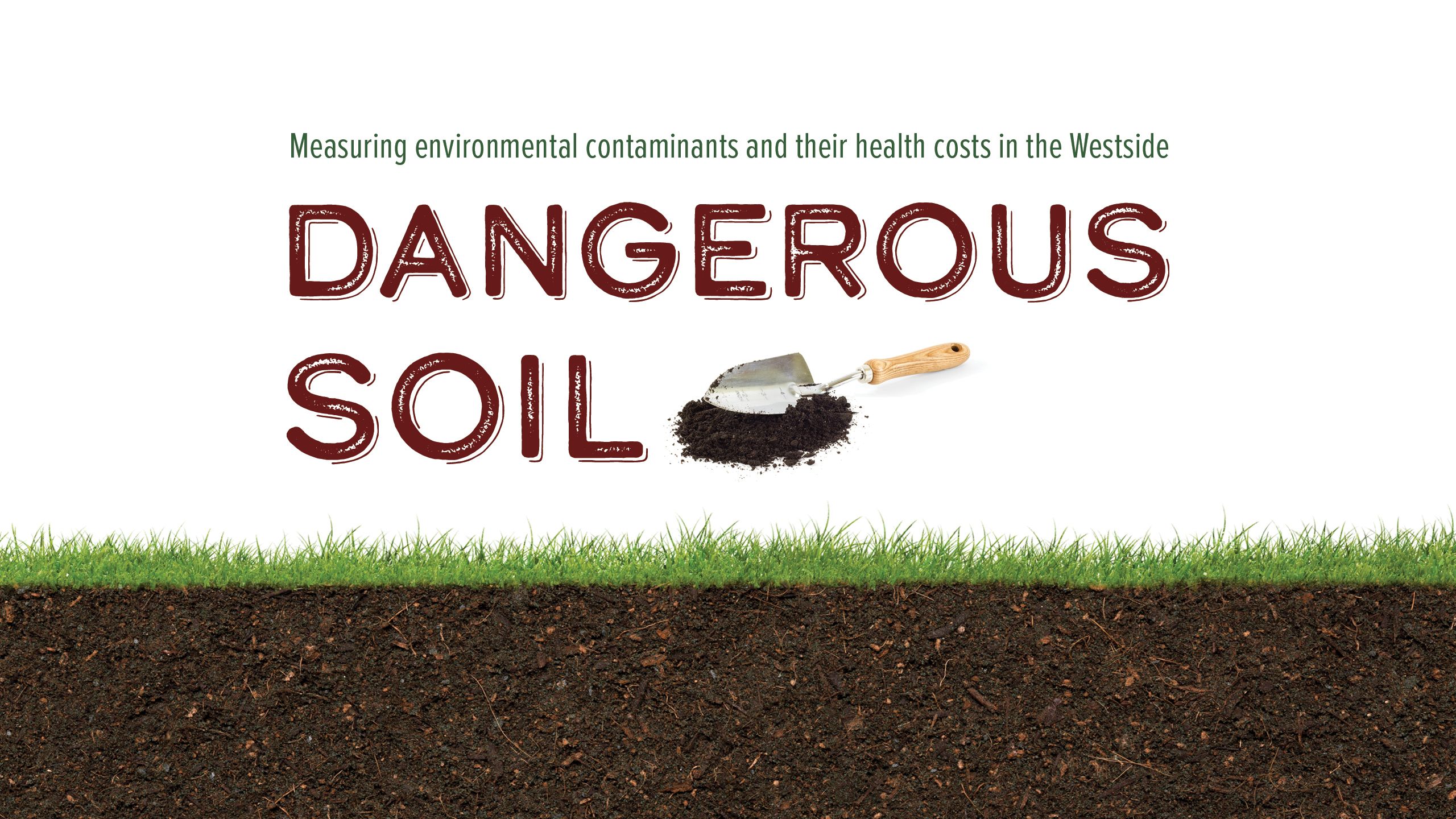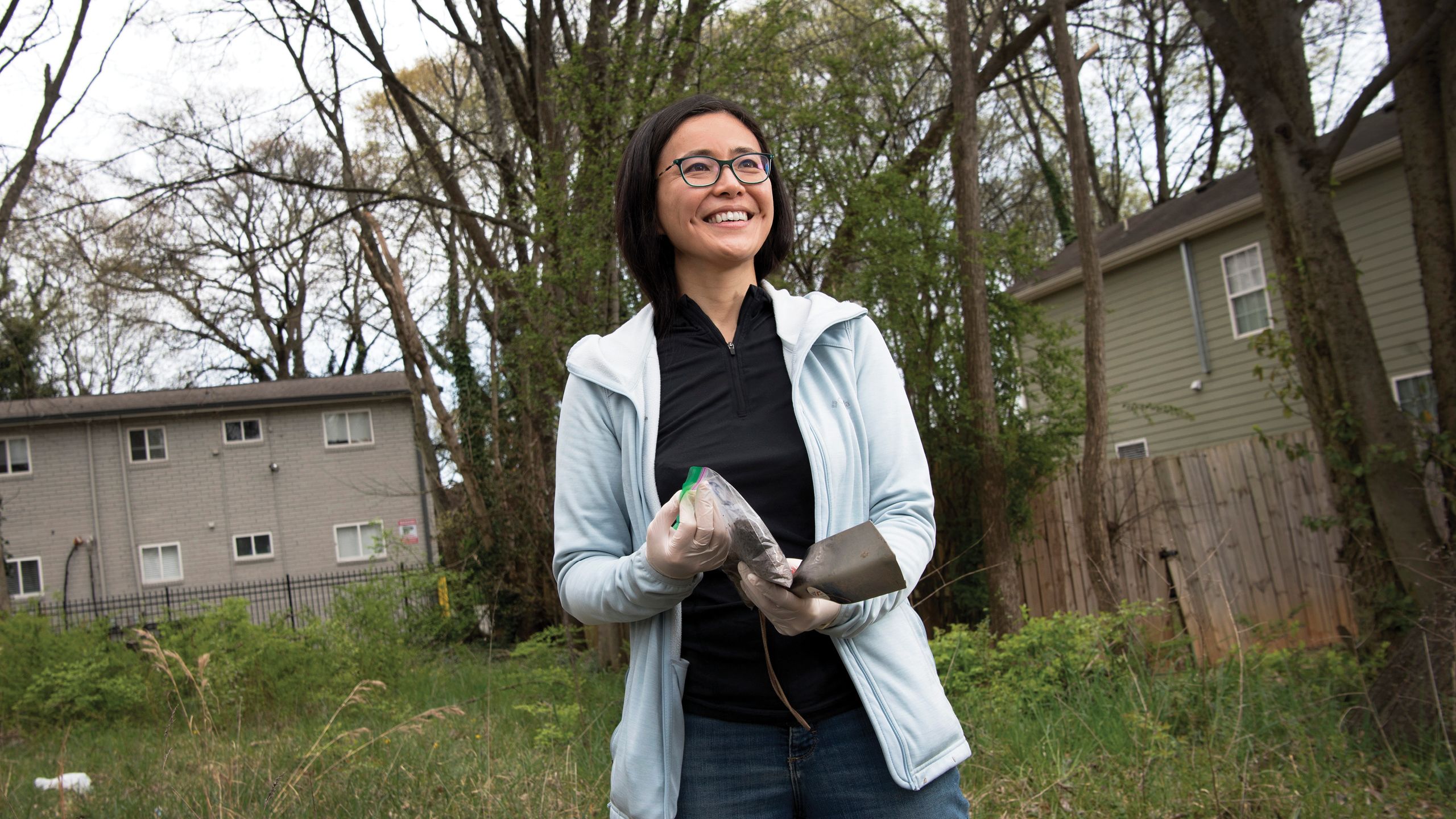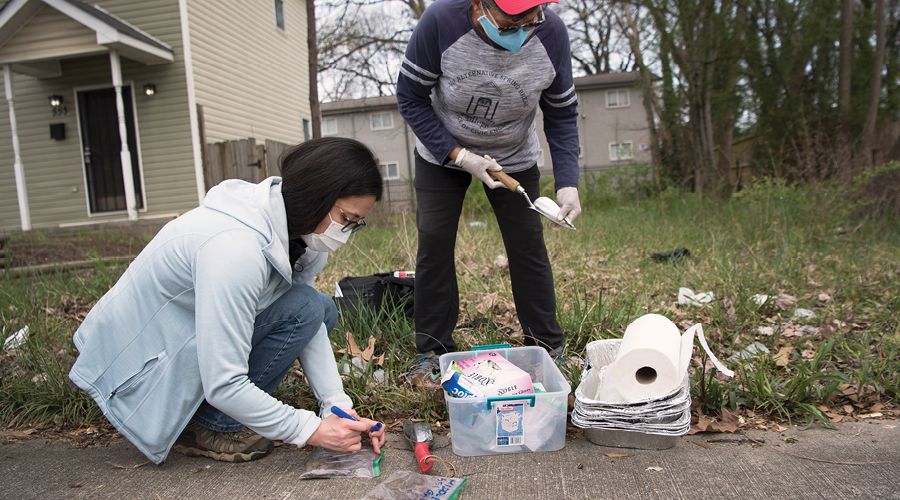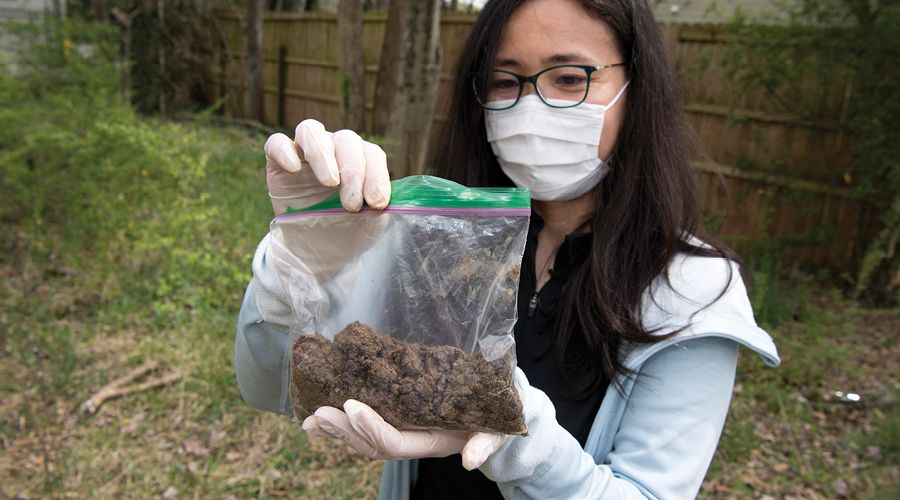Dangerous Soil
Measuring environmental contaminants and their health costs in the Westside

It’s a tight fit in Louana Joseph’s living room on a muggy July afternoon. Eri Saikawa, associate professor of environmental health, and seven Emory undergraduate and graduate students from her lab crowd in a rag-tag circle around Joseph, who bounces her 10-month-old daughter, Marlie, on her hip. Two-year-old Maurice “MJ” alternates between hopping on the brown sectional sofa and squeezing between the students to check out their Apple watches.
After introductions, the students disperse in small, busy groups. A few step outside to collect soil samples from the strip of land in front of Joseph’s apartment and the playground around the corner. Others begin meticulously vacuuming small sections of the floor, while another records Joseph’s answers to a lengthy list of questions. Saikawa squats in front of MJ, flapping her arms in an effort to get him to do the same before another student attaches a small device on his arm to painlessly draw a small sample of blood.

Joseph is unperturbed by the chaotic buzz in her apartment. “It seems like I always have a lot of people in here,” she says. “I’m the baby of six, and everyone has children. For some reason, everybody always comes here, even though some of the others have houses. Maybe it’s because I cook.
“So I’m fine with having this group here, especially if they can make sure nothing bad is happening here,” she continues. “You want to do everything you can to make sure your children are safe and healthy.”
And that’s exactly what Saikawa and her team are trying to do. Joseph’s apartment on Martin Luther King Jr. Drive in Atlanta’s Westside is the first site visit in Saikawa’s $1.35 million US Environmental Protection Agency (EPA)-funded study. Her team will collect soil, dust, and paint samples from Joseph’s apartment and its environs as well as blood and urine samples from MJ and Marlie. Everything will be analyzed back in Emory laboratories, testing for heavy metals and metalloids, including lead, and other environmental toxicants in the soil, dust, and paint. The children’s bodily fluids will be assessed for exposure to such toxins.
This study builds off the work Saikawa and a Rollins graduate student started four years ago when they identified high levels of lead in the soil in some Westside plots, including some used for urban gardening. Their discovery led to the area, which is a low-income, mostly minority community, being classified as an EPA Superfund site. It was recently upgraded to the EPA’s National Priority List. Saikawa and her team are now trying to determine the human health cost of high lead levels and other environmental toxicants in the Westside area.
“According to the CDC, there is no safe level of lead exposure,” says Saikawa.
Especially for children, who absorb as much as 90 percent more of the powerful neurotoxin into their bodies than adults. Even at low levels, lead has been linked to intellectual disabilities and impulse control issues. At higher levels it can stunt growth.
“Overall, we’ve done a good job of reducing exposure worldwide by eliminating lead in gasoline and paint products,” says Saikawa, who is also associate professor of environmental sciences in Emory College of Arts and Sciences.
“But there can still be other sources of lead in and near the homes where children live and play,” she continues. “We are trying to find some of these sources and how they affect children in the hopes the EPA and local governments can better regulate and mitigate environmental contaminants, especially in low-income, urban areas.”

Joseph is unperturbed by the chaotic buzz in her apartment. “It seems like I always have a lot of people in here,” she says. “I’m the baby of six, and everyone has children. For some reason, everybody always comes here, even though some of the others have houses. Maybe it’s because I cook.
“So I’m fine with having this group here, especially if they can make sure nothing bad is happening here,” she continues. “You want to do everything you can to make sure your children are safe and healthy.”
And that’s exactly what Saikawa and her team are trying to do. Joseph’s apartment on Martin Luther King Jr. Drive in Atlanta’s Westside is the first site visit in Saikawa’s $1.35 million US Environmental Protection Agency (EPA)-funded study. Her team will collect soil, dust, and paint samples from Joseph’s apartment and its environs as well as blood and urine samples from MJ and Marlie. Everything will be analyzed back in Emory laboratories, testing for heavy metals and metalloids, including lead, and other environmental toxicants in the soil, dust, and paint. The children’s bodily fluids will be assessed for exposure to such toxins.

“Overall, we’ve done a good job of reducing exposure worldwide by eliminating lead in gasoline and paint products. But there can still be other sources of lead in and near the homes where children live and play. We are trying to find some of these sources and how they affect children.” — Eri Saikawa
“Overall, we’ve done a good job of reducing exposure worldwide by eliminating lead in gasoline and paint products. But there can still be other sources of lead in and near the homes where children live and play. We are trying to find some of these sources and how they affect children.” — Eri Saikawa
This study builds off the work Saikawa and a Rollins graduate student started four years ago when they identified high levels of lead in the soil in some Westside plots, including some used for urban gardening. Their discovery led to the area, which is a low-income, mostly minority community, being classified as an EPA Superfund site. It was recently upgraded to the EPA’s National Priority List. Saikawa and her team are now trying to determine the human health cost of high lead levels and other environmental toxicants in the Westside area.
“According to the CDC, there is no safe level of lead exposure,” says Saikawa.
Especially for children, who absorb as much as 90 percent more of the powerful neurotoxin into their bodies than adults. Even at low levels, lead has been linked to intellectual disabilities and impulse control issues. At higher levels it can stunt growth.
“Overall, we’ve done a good job of reducing exposure worldwide by eliminating lead in gasoline and paint products,” says Saikawa, who is also associate professor of environmental sciences in Emory College of Arts and Sciences.
“But there can still be other sources of lead in and near the homes where children live and play,” she continues. “We are trying to find some of these sources and how they affect children in the hopes the EPA and local governments can better regulate and mitigate environmental contaminants, especially in low-income, urban areas.”


SOURCE OF A SUPERFUND SITE

In 2018, the City of Atlanta was encouraging city residents to take up urban gardening. At that time, Sam Peters was a PhD student in environmental health who was looking to add a health-related component to his dissertation. Saikawa suggested sampling the soil in some of the proposed urban gardens to test for levels of heavy metals and metalloids.
One of the 11 plots Peters tested was the Westside, and it came back with extremely high levels of lead—higher than the EPA threshold of 400 parts per million (ppm). By way of comparison, the University of Georgia’s threshold for agricultural soil is 75 ppm. Concerned, Peters and Saikawa decided to test more sites. They teamed up with a community group active in the area, Historic Westside Gardens, and secured funding from Emory’s HERCULES Exposome Research Center, which studies the interconnection between environmental exposures, biological responses, and societal factors. They assembled a team to gather more samples and found more lots that were tainted with lead.

“When we started, we thought we might find some levels of contamination,” says Peters 19G, who is now a senior data scientist with Indigo Agriculture. “But we definitely did not expect to find areas with such high concentrations of lead or to find the problem as widespread as it turned out to be.”
Saikawa was able to attract the EPA’s attention when she invited a colleague from the agency, Tim Frederick 96MPH, to attend a Westside tomato festival where she planned to offer testing of soil samples attendees brought. Frederick, chief of the Scientific Support Section for the EPA’s Superfund and Emergency Management Division, would supply the testing expertise.
While they were testing samples, one resident came up with an odd-looking rock she found in her yard. “I took one look at it and said, ‘That is not a rock. That is slag, and it’s a good bet that is where the lead in the soil is coming from,’” says Frederick.
Slag is a waste byproduct of smelting and steel-making processes, and it can often contain lead. In the early to mid-1900s, it was common practice to use industrial waste as infill for roads and low-lying areas. The Westside used to be home to several metal foundries.

The resident who brought the slag to Frederick’s attention was Rosario Hernandez, an outspoken neighborhood activist, and hers was the first garden plot that was found with lead levels of greater than 400 ppm. Her daughter and grandchildren were living next door to her at the time, and the grandchildren, who ate food from her backyard garden and played in the yard, had developmental delays. Hernandez wanted to know if the lead in her soil could be the reason.
Frederick brought some people from the EPA’s emergency response unit to Hernandez’s house to inspect her yard. They found more pieces of slag, and across the street in an abandoned lot was an entire mound of it. “It looked like a dump truck had just dumped a load of it and left it,” Frederick says.
“After we got approval from the state thanks to a report submitted by Eri and Sam, we went back and started looking around the neighborhood,” Frederick continues. “We thought it was just going to be Rosario’s yard and the pile across the street, but the more we walked around the neighborhood, the more slag we saw. Once it reached a critical mass, it outstripped the ability of our emergency response folks to handle it. That’s when we started the process of having the area added to the Superfund program.”


THE SITE EXPANDS

Since its designation as a Superfund site in 2019, the boundaries have increased several times to now include 2,097 properties spread across nearly one square mile of the Vine City and English Avenue neighborhoods. The EPA has been able to obtain permission to test the soil on about half of those properties, and of those tested, about 40 percent have lead levels greater than 400 ppm. As of late August, 147 sites have been remediated, which involves excavating the soil on the property, replacing it with clean soil and then adding a layer of topsoil. The EPA estimates the total cost of the remediation will be close to $50 million and be completed by 2028.
In March, the site was added to the EPA’s National Priority List (NPL), which is reserved for sites that the agency has found pose a serious risk to residents’ health and the environment and will require a long-term cleanup. According to the EPA, nearly two out of three of the sites being proposed or added to the NPL are in underserved communities.
“This Westside site is definitely a priority for the EPA because of the environmental justice concerns it raises,” says Leigh Lattimore, the EPA’s remedial project manager for the site. “All children deserve
the right to grow up in a neighborhood where it’s safe to play in the yards of their homes, schools, and churches.”


TRYING DIY REMEDIATION

Remediation by the EPA takes time in the best of circumstances. Add a global pandemic and the process is slowed considerably. In the meantime, children continue being exposed.
So Saikawa and her students tried to find low-cost ways the residents could do it on their own. Alicia Wun, 20MPH tried growing sunflowers in Hernandez’s yard to test their ability to remove lead from the soil. “Sunflowers will grow in almost anything, and they grow fast,” says Wun, who is now a clinical research coordinator with Seattle Children’s Research Division. “They can draw up lead from the soil and store them in their roots and stems—a process called phytoremediation. Plus, they are beautiful.”
Unfortunately, the amount of lead the sunflowers were able to remove was low.
Xinyi Yao 20G tried a variation of that theme, growing four different plants in soil with high lead levels in the lab. Of the four plants tested, one was effective at removing the lead—cowpeas. However, the plant stored the lead in its edible part, making it a risky solution if children decided to eat the legume. “It was disappointing, but we were not able to find low-cost ways the residents could remediate their own soil,” says Saikawa.


THE HUMAN HEALTH COST OF DIRTY SOIL

The current project will involve areas of the Westside outside of the current EPA investigation site. The research team plans to test the homes and yards of willing participants for a total of 40 other organic and inorganic environmental toxicants. They plan to recruit 100 households to participate in environmental sampling and obtain permissions to gather biological samples of blood and urine from 140 children ages six months to six years to test for exposures.
Dana Barr, professor of environmental health, is co-principal investigator on the grant. Ziad Kazzi, associate professor in Emory Medical School’s Department of Emergency Medicine and an expert in medical toxicology, is a co-investigator. Saikawa’s lab will focus on recruiting participants like Louana Joseph, conducting surveys with community members, and gathering environmental samples of soil, household dust, and paint chips. Her team will analyze these samples for heavy metals and metalloids, as well as modeling exposures from these various pathways.
Barr’s lab will primarily focus on analyses of the biological and other environmental samples for a broader range of potential organic and inorganic toxicants. Kazzi will help address health and medical concerns that may arise from the community.
“This project is unique and important,” says Barr, who co-directs Rollins’ Laboratory for Exposure Assessment and Development in Environmental Research Lab (LEADER). “We’re not just analyzing environmental samples for toxicants, we’re also testing children for potential exposures and evaluating possible mitigation strategies.”
If the study links health issues in the children with toxicants in their environment, Saikawa hopes the results can be used to inform community residents as well as federal and state policy makers. “Ultimately, we want to raise awareness of the Westside community members and provide them with educational materials specific to their needs to help lower the risks of their families being exposed to toxicants,” says Saikawa. “We also hope our data will help in the development of holistic regulatory frameworks to prevent exposures to environmental contaminants in underserved communities around the country.”


A CAREER TURNING POINT

Saikawa describes the Westside project as a turning point in her career. After graduating with a degree in engineering in Japan, she came to the US with the goal of working in environmental programs in the United Nations or the World Bank. “I got into environmental science because I wanted to reduce air pollution,” she says. “But I thought I would do that from my computer. I was basically a modeler. I didn’t like the outdoors, and I’m not much of a people person. I actually enjoy staring at my computer and not talking to people much.”
Then she got involved in the Westside project. “That was the first time I really saw how people are impacted by the problem, and how meaningful it was to work together to find solutions in ways I never thought about,” she says. “Now I spend quite a bit of my time outdoors, and I don’t even mind the bugs.”
Saikawa now defines herself as a community scientist. “This project has really changed the way I see environmental science,” she says. “It’s not just the sciences, it’s also humanities and social sciences. It’s really how can we combine different knowledge and different disciplines to work on very big environmental problems. Science itself cannot do everything. You need also to be an activist to make sure that science is used in policy making.”
She says she is still not much of a people person. An observer may argue that point after watching Saikawa talk and laugh easily with her students and study participants while she flaps her arms for a toddler in between accepting his hugs.—Carol Clark contributed to this article.
Story by Martha Nolan
Designed by Linda Dobson
Photography by Kay Hinton

Saikawa describes the Westside project as a turning point in her career. After graduating with a degree in engineering in Japan, she came to the US with the goal of working in environmental programs in the United Nations or the World Bank. “I got into environmental science because I wanted to reduce air pollution,” she says. “But I thought I would do that from my computer. I was basically a modeler. I didn’t like the outdoors, and I’m not much of a people person. I actually enjoy staring at my computer and not talking to people much.”

Then she got involved in the Westside project. “That was the first time I really saw how people are impacted by the problem, and how meaningful it was to work together to find solutions in ways I never thought about,” she says. “Now I spend quite a bit of my time outdoors, and I don’t even mind the bugs.”
Saikawa now defines herself as a community scientist. “This project has really changed the way I see environmental science,” she says. “It’s not just the sciences, it’s also humanities and social sciences. It’s really how can we combine different knowledge and different disciplines to work on very big environmental problems. Science itself cannot do everything. You need also to be an activist to make sure that science is used in policy making.”
She says she is still not much of a people person. An observer may argue that point after watching Saikawa talk and laugh easily with her students and study participants while she flaps her arms for a toddler in between accepting his hugs.—Carol Clark contributed to this article.
Story by Martha Nolan
Designed by Linda Dobson
Photography by Kay Hinton

Want to know more? Please visit
Rollins Magazine
Emory News Center
Emory University

